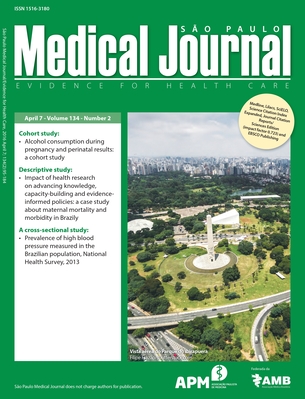Malignant catatonia responsive to low doses of lorazepam
case report
Keywords:
Catatonia, Benzodiazepines, Lorazepam, Depressive disorder, Case reports [publication type]Abstract
CONTEXT: Catatonia can be divided into non-malignant or malignant. The latter is characterized by autonomic instability, exhibiting high fever, tachycardia and hypertension, and is regarded as a fulminant and rapidly progressive subtype. CASE REPORT: This article reports a case of malignant catatonia in a 43-year-old patient who had been presenting psychiatric disorders for the last three years. The patient was stable, maintaining mutism, immobility and autonomic abnormalities. Oral lorazepam (1 mg every eight hours) was introduced and, in a few hours, the patient became afebrile. Two days later, the patient was already responding to verbal commands. CONCLUSIONS: Early intervention with lorazepam reduced the evolution of this patient to a fatal complication. Therefore, this case report sought to show that early diagnosis and intervention reduced the occurrence of serious and irreversible clinical outcomes.
Downloads
References
Taylor MA, Fink M. Catatonia in psychiatric classification: a home of its own. Am J Psychiatry. 2003;160(7):1233-41.
Fink M. Catatonia: a syndrome appears, disappears, and is rediscovered. Can J Psychiatry. 2009;54(7):437-45.
Lin CC, Huang T. Lorazepam-diazepam protocol for catatonia in schizophrenia: a 21-case analysis. Compr Psychiatry. 2013;54(8):1210-4.
Tibrewal P, Narayanaswamy J, Zutshi A, Srinivasaraju R, Math SB. Response rate of lorazepam in catatonia: a developing country’s perspective. Prog Neuropsychopharmacol Biol Psychiatry. 2010;34(8):1520-2.
de Entrambasaguas M, Sánchez JL, Schonewille W. Catatonia maligna [Malignant catatonia]. Rev Neurol. 2000;30(2):132-8.
Francis A, Fink M, Appiani F, et al. Catatonia in Diagnostic and Statistical Manual of Mental Disorders, Fifth Edition. J ECT. 2010;26(4):246-7.
Fink M, Taylor MA. The catatonia syndrome: forgotten but not gone. Arch Gen Psychiatry. 2009;66(11):1173-7.
Detweiler MB, Mehra A, Rowell T, Kim KY, Bader G. Delirious mania and malignant catatonia: a report of 3 cases and review. Psychiatr Q. 2009;80(1):23-40.
Glover SG, Escalona R, Bisho J, Saldivia A. Catatonia associated with lorazepam withdrawal. Psychosomatics. 1997;38(2):148-50.
Taylor MA, Abrams R. Catatonia. Prevalence and importance in the manic phase of manic-depressive illness. Arch Gen Psychiatry. 1977;34(10):1223-5.
Gelenberg AJ. The catatonic syndrome. Lancet. 1976;1(7973):1339-41.
Moreira CN, Souza GFJ. Esquizofrenia catatônica. Casos Clínicos em Psiquiatria. 2000;2(2):66-70.
Rizos DV, Peritogiannis V, Gkogkos C. Catatonia in the intensive care unit. Gen Hosp Psychiatry. 2011;33(1):e1-2.
Ungvari GS, Chiu HF, Chow LY, Lau BS, Tang WK. Lorazepam for chronic catatonia: a randomized, double-blind, placebo-controlled cross-over study. Psychopharmacology (Berl). 1999;142(4):393-8.
Cottencin O, Thomas P, Vaiva G, Rascle C, Goudemand M. A case of agitated catatonia. Pharmacopsychiatry. 1999;32(1):38-40.
Ramdurg S, Kumar S, Kumar M, et al. Catatonia: Etiopathological diagnoses and treatment response in a tertiary care setting: A clinical study. Ind Psychiatry J. 2013;22(1):32-6.
Petrides G, Divadeenam KM, Bush G, Francis A. Synergism of lorazepam and electroconvulsive therapy in the treatment of catatonia. Biol Psychiatry. 1997;42(5):375-81.
Rey JM, Walter G. Half a century of ECT use in young people. Am J Psychiatry. 1997;154(5):595-60.






